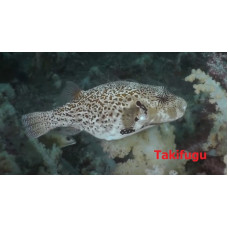Tetraodontidae is a family of fishes of the order Tetraodontiformes. The body is shortened, covered with small spines or naked. The teeth of the upper and lower jaws are fused together in separate plates, divided in front in the middle. About 20 genera, more than 120 species. Marine freshwater fish. Inhabit tropical and subtropical waters of the world's oceans. Body length up to 75 cm. Skin, peritoneum, liver gonads of most fish are poisonous. Omnivorous fish. Marine Tetraodontidae are commercial fishes, small forms of freshwater fishes are objects of aquarium fish breeding.
Fish meat is highly valued in Southeast Asian countries for its flavor. In Japan, fugu, a dish made from several species of fish, is a particular favorite. The chef preparing it must have a diploma of graduation from a special school, as the skin and some internal organs of fish are deadly poisonous.
The body of pufferfish is short and rounded. They are generally small to medium-sized, although some species can reach lengths of more than 1 m.
Pufferfish have pouch-like growths extending from their stomachs. When threatened, they fill with water or air, making the fish look like an inflated balloon with protruding spines. Fish can inflate by swallowing water if attacked. The balloon-like state makes the fish virtually invulnerable. If still large enough predator tries to swallow such a ball, it gets stuck in the throat of the predator, which subsequently dies. The fish themselves are carnivorous or omnivorous.
Due to the presence of special muscles pufferfish can move with the pectoral fins not only forward, but also backward, which increases the maneuverability of these fish. The presence of a large air sac coming off the stomach, allows these fish to inflate into a balloon when filled with water or air. Pulled out of the water, the fish immediately swallows the air and inflates before your eyes. Thrown back into the water, it swims belly up for a while and seems quite helpless, unable to submerge. Then, noisily releasing air, it quickly goes underwater and seeks to hide in some shelter. Under water, these fish, when an attempt is made to attack them, when they have nowhere to hide, swell up, swallowing water. In this form, they are virtually invulnerable. However, there are known cases when large predatory fish tried to swallow such a balloon, but it ended tragically for them: they were found dead with a victim stuck in their throat.
Reproduction is best traced in freshwater Tetraodon cutcutia, up to 8 cm long. After mating games, when the male and female of this species walk in circles over the bottom of the aquarium, the female lays 200-300 transparent eggs on the rocks. The clutch is guarded by the male, covering it with his body. After 6-8 days from the eggs hatch tadpole-like larvae, which spend several days lying on the bottom. The male carries them to a hole made in the ground and protects them for some time. After resorption of the yolk sac, the juveniles switch to active feeding, ingesting infusoria.
The species Torquigener albomaculosus was called "the greatest artist of the animal kingdom" by David Attenborough because of the unique habit of males courting females by creating nests in the sand composed of intricate geometric patterns.
Tetraodontidae
Tags: tetraodontidae



